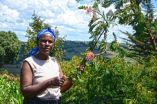(Press-News.org) Farmers in Africa can increase their food production if they avoid over dependence on chemical fertilizers, pesticides and practice agricultural intensification - growing more food on the same amount of land – using natural and resource-conserving approaches such as agroforestry.
According to scientists at the World Agroforestry Centre (ICRAF), crop production in Africa is seriously hampered by the degradation of soil fertility, water and biodiversity resources. Currently, yields for important cereals such as maize have stagnated at 1 tone per hectare. Climate change and increasing demand for food, animal fodder and fuel is likely to worsen the situation.
To meet the needs of an ever growing population, scientists say farmers can increase production and conserve natural resources by turning to agricultural intensification through agroforestry, an integrated land use management technique that incorporates trees and shrubs with crops and livestock on farms.
This approach brings ecosystems, livelihoods and agriculture together. Replenishing soils, improving biodiversity and lessening agricultural pollution. It also decreases threats to food security and earned farming incomes - according to Sammy Carsan, a tree domestication scientist with ICRAF and lead author of a recent article on agroforestry and agricultural intensification.
In many parts of Asia, intensification has been achieved through the use of greater inputs such as chemical fertilizers, but it has come at a cost – causing soil degradation, loss of biodiversity and pollution which has impacted on food security and income earned from farming.
While growing more food on the same area of land is key to increasing sustainable food production and meeting the needs of an ever-growing population, farmers should avoid intensification that relies on heavy use of chemical fertilizers and pesticides. Chemical fertilizers increase production in the short-term, but with time soils become increasingly degraded and broken down until there is very little organic matter or nutrients left. When soils are in this state, crops are unable to utilize the fertilizer and production is low.
"A long-term solution to intensification in Africa should not purely be based on an imported intensification model but instead consider approaches that can maintain the quality of the available resource base through ensuring nutrient cycling, organic matter build-up, biodiversity improvements and water quality regulation," says Carsan,
Agroforestry practices provide appropriate technologies for maintaining resilient farms and ecosystems that make up the landscapes that provide food and livelihoods across rural Africa.
INFORMATION: END
Crop intensification can be a long-term solution to perennial food shortages in Africa
Growing more food on the same size of land is key to increasing food production in Africa to meet the needs of an ever-growing population
2014-03-18
ELSE PRESS RELEASES FROM THIS DATE:
Archaeologists discover the earliest complete example of a human with cancer
2014-03-18
Archaeologists have found the oldest complete example in the world of a human with metastatic cancer in a 3,000 year-old skeleton.
The findings are reported in the academic journal PLOS ONE today (17 March).
The skeleton of the young adult male was found by a Durham University PhD student in a tomb in modern Sudan in 2013 and dates back to 1200BC.
Analysis has revealed evidence of metastatic carcinoma, cancer which has spread to other parts of the body from where it started, from a malignant soft-tissue tumour spread across large areas of the body, making it ...
New therapeutic target identified for acute lung injury
2014-03-18
Augusta, Ga. – A bacterial infection can throw off the equilibrium between two key proteins in the lungs and put patients at risk for a highly lethal acute lung injury, researchers report.
Bacteria can alter a single amino acid in the protein RhoA, pushing its activity level well above that of Rac1 and prompting blood vessels to leak and flood thousands of tiny air sacs in the lungs, said Dr. Stephen Black, cell and molecular physiologist at the Medical College of Georgia at Georgia Regents University.
The study in The Journal of Biological Chemistry also proposes ...
Researchers identify risk factors for little-known lung infection
2014-03-18
Severe and sometimes fatal lung disease caused by a group of bacteria in the same family as those that cause tuberculosis is much more common than previously thought, with Caucasians 55 and older at greatest risk, report researchers from the University of Illinois at Chicago College of Medicine.
The study is published online March 14 in PLOS ONE.
Nontuberculous mycobacteria (NTM) include more than 150 types of bacteria, found in water and soil, that can infect the lungs when inhaled. Unlike tuberculosis, NTM is not contagious and cannot spread from person to person. The ...
Computer analyzes massive clinical databases to properly categorize asthma patients
2014-03-18
PITTSBURGH—So many variables can contribute to shortness of breath that no person can keep them all straight. But a computer program, capable of tracking more than 100 clinical variables for almost 400 people, has shown it can identify various subtypes of asthma, which perhaps could lead to targeted, more effective treatments.
Wei Wu, a Carnegie Mellon University computational biologist who led the analysis of patient data from the federally funded Severe Asthma Research Program, said many of the patient clusters identified by the computational methods are consistent ...
Cosmic inflation finding first predicted by JHU cosmologist
2014-03-18
A team of observational cosmologists may have found evidence that cosmic inflation occurred a fraction of a second after the Big Bang, a point predicted 18 years ago by Johns Hopkins University cosmologist and theoretical physicist Marc Kamionkowski.
At a news conference earlier today at the Harvard-Smithsonian Center for Astrophysics in Cambridge, Mass, researchers from the BICEP2 collaboration, a partnership between Harvard University and the California Institute of Technology, announced the first direct evidence for this sudden and vast expansion of the newborn universe. ...
UCLA geographers create 'easy button' to calculate river flows from space
2014-03-18
The frustrated attempts of a UCLA graduate student to quantify the amount of water draining from Greenland's melting ice sheet led him to devise a new way to measure river flows from outer space, he and his professor report in a new study.
The new approach relies exclusively on the measurements of a river's width over time, which can be obtained from freely available satellite imagery.
Currently, hydrologists calculate a river's discharge — the volume of water running through it at any given time — by taking a series of measurements on the ground, including not ...
Workplace flexibility still a myth for most
2014-03-18
CHESTNUT HILL, MA (March 17th): Workplace flexibility – it's a phrase that might be appealing to job seekers or make a company look good, but a new study by the Sloan Center on Aging and Work at Boston College shows flexible work options are out of reach for most employees and that when they are offered, arrangements are limited in size and scope.
"While large percentages of employers report that they have at least some workplace flexibility, the number of options is usually limited and they are typically not available to the entire workforce," says Marcie Pitt-Catsouphes, ...
Drug trafficking corrupts Kyrgyzstan's politics and underworld
2014-03-18
PRINCETON, N.J.—Kyrgyzstan, a landlocked and mountainous country in Central Asia, serves a powerful role in the Eurasian drug trade by playing the "mule" that carts heroin and other opiates between Afghanistan and Russia. Many researchers theorize that this lucrative industry has taken root in Kyrgyzstan – a country with few natural resources and industries – with significant support and leeway from its government, making it a "narco-state."
In the first examination of its kind, a researcher at Princeton University's Woodrow Wilson School writes in the International ...
Innovative computer under scrutiny
2014-03-18
D-Wave – a special computing machine with this name has been getting computer scientists and physicists talking for a number of years now. The Canadian technology company of the same name is advertising the machine as a quantum computer. However, whether or not the machine does in fact use quantum effects is the subject of controversial debate amongst experts in the field. If it does, then this would make D-Wave the world's first commercially available quantum computer.
The company sold its system to illustrious customers, piquing the interest of the scientific community ...
NASA satellite sees Tropical Cyclone Gillian return to remnant low status
2014-03-18
NASA's Aqua satellite captured a visible image of Tropical Cyclone Gillian's remnants in the southern Arafura Sea today, as it passes north of Australia's "Top End."
During the week of March 10, Tropical Cyclone Gillian formed in the northern Gulf of Carpentaria and made a brief landfall on the Western Cape York Peninsula, weakening to a remnant low. After re-emerging in the Gulf, Gillian became a tropical storm again and by March 17 had again weakened to a remnant low as it exited the Gulf and moved into the Arafura Sea.
The MODIS or Moderate Resolution Imaging Spectroradiometer ...
LAST 30 PRESS RELEASES:
Safety decision-making for autonomous vehicles integrating passenger physiological states by fNIRS
Fires could emit more air pollution than previously estimated
A new way to map how cells choose their fate
Numbers in our sights affect how we perceive space
SIMJ announces global collaborative book project in commemoration of its 75th anniversary
Air pollution exposure and birth weight
Obstructive sleep apnea risk and mental health conditions among older adults
How talking slows eye movements behind the wheel
The Ceramic Society of Japan’s Oxoate Ceramics Research Association launches new international book project
Heart-brain connection: international study reveals the role of the vagus nerve in keeping the heart young
Researchers identify Rb1 as a predictive biomarker for a new therapeutic strategy in some breast cancers
Survey reveals ethical gaps slowing AI adoption in pediatric surgery
Stimulant ADHD medications work differently than thought
AI overestimates how smart people are, according to HSE economists
HSE researchers create genome-wide map of quadruplexes
Scientists boost cell "powerhouses" to burn more calories
Automatic label checking: The missing step in making reliable medical AI
Low daily alcohol intake linked to 50% heightened mouth cancer risk in India
American Meteorological Society announces Rick Spinrad as 2026 President-Elect
Biomass-based carbon capture spotlighted in newly released global climate webinar recording
Illuminating invisible nano pollutants: advanced bioimaging tracks the full journey of emerging nanoscale contaminants in living systems
How does age affect recovery from spinal cord injury?
Novel AI tool offers prognosis for patients with head and neck cancer
Fathers’ microplastic exposure tied to their children’s metabolic problems
Research validates laboratory model for studying high-grade serous ovarian cancer
SIR 2026 delivers transformative breakthroughs in minimally invasive medicine to improve patient care
Stem Cell Reports most downloaded papers of 2025 highlight the breadth and impact of stem cell research
Oxford-led study estimates NHS spends around 3% of its primary and secondary care budget on the health impacts of heat and cold in England
A researcher’s long quest leads to a smart composite breakthrough
Urban wild bees act as “microbial sensors” of city health.
[Press-News.org] Crop intensification can be a long-term solution to perennial food shortages in AfricaGrowing more food on the same size of land is key to increasing food production in Africa to meet the needs of an ever-growing population



